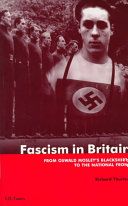Intro
The Yellow Submarine film (link – pdf) tells us about a society in crisis, demoralized, and possibly “decadent” by their own standards. It traces the emergence, attempted assimilation, and ultimate success of the compensatory and highly idiosyncratic messianic surge in that milieu, whose main catalyst was the musical rock and roll/ballad band The Beatles. In sheer contradistinction with the society depicted (or perhaps caricatured in the movie), the Yellow Submarine film was a genuine attempt to forward the claim that art and music are more efficient integrating forces than bigotry and lack of compromise. These traits were, I venture say, obvious to the makers of the Yellow Submarine film, who dealt with it with gossamer artist gloves.
The Yellow Submarine film: some clues
My prime concern while working on the musical setting of the Book of Revelation (Juscheld – Apocalypsis Iesu oratorio) was to find a coherent structure that would support both the music (musical form) and do justice to the imagery and message of that book (literary structure and signification). Soon it became clear that I had to find a middle ground between the literary conventions employed by John of Patmos [1]pdf for broken links and the musical canons that I, as a composer, may use: in other words, I needed to search for a common structural basis, if such a thing existed at all. While researching on these matters I noticed that the literary structures John of Patmos was using had a lot in common, not only with apocalyptic literature in general, but also with other genres such as the one to which the imagery structure of Yellow Submarine film belongs. These genres include the widespread mythological narratives involving journeys, transformations (especially those that involve illumination), or in our particular case underwater adventures and visits to the underworld.
John’s book, incidentally, describes the opposite arch so to say, and responds to the mythologem of the sudden “snatching” into heaven (exemplified perhaps in Ganymede’s episode), and whose roots may go all the way to the shaman’s ecstatic experience.
The Social Context and The Beatles
I will be concerned mostly with the social realities that may have inspired, in my belief, the imaginative outpour displayed in the Yellow Submarine film, inspired by The Beatles’ iconic song Yellow Submarine. Far from undervaluing the song’s artistic merits, what is relevant to me here is the fact that the film is inextricably (and inevitably) enmeshed in the fabric of our very recent times, that it is a testimony of a momentous change in the social consciousness of the late 20th and early 21st century, and that it connects directly (and possibly unavoidably) with the deepest currents of spirituality and religious fervour of these otherwise secular societies that have contributed to shape the overall consciousness of our modern world. The emergence of a “yellow” submarine from the psychedelic chaos of the underworld, where blue tyrannical demons reign, ties with the deeply symbolic occurrence of a newly risen sun.

The four Beatles (portrayed as cartoon characters in the movie, therefore imaginatively expanded so to say) are the promoted and eventually idealized members of a society (post-Victorian Britain) who succeed (at any rate in the film) in constructively channelling the swell of mostly repressed emotion that accompanies the gradual and inevitable loss or wane of dignity and status of a community or nation in decline.
The latter case is usually accompanied by an overcompensating rigidity and authoritarianism that was temporarily suspended ideologically (but not for long) by the impact, and far-reaching consequences, of the social phenomenon with which The Beatles became associated, possibly quite involuntarily but certainly as prime representatives. These four charismatic musicians, through charming melodies, compelling slogans about love, possessed rebellious but non-destructive and socially absorbable attitudes. Ironically, The Beatles also succeeded in giving shape and materializing in a consumable manner the means by which the ruling hierarchy could exert soft control and leadership over the growing and possibly seditious discontent of significant sectors of the British society, especially those possessing specific historical and class identities. That society has now de facto disappeared, diluted in the new social dynamics of the 21st century, with its cosmic financial debt, protracted wars, mass migrations, planetary ailments, and the inevitable societal macro-engineering and re-education that comes with it all. That movement, the phenomenon that The Beatles artistically characterized, is now a thing of the past; but the problematic that gave rise to it, and made it almost a necessity, is now more acute than ever. Gone are too the long hair and love songs, but not the tyrants and the demonic forces that plague our world, now more than ever.
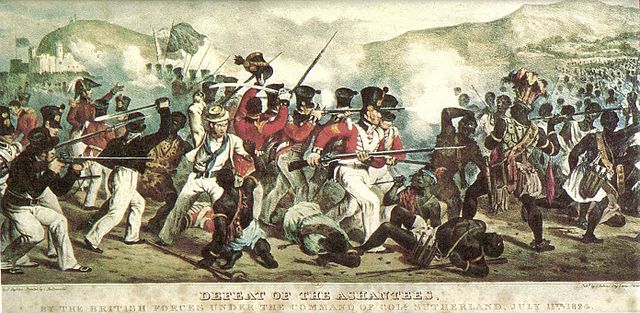
The Beatles were the first global catalyst at a time when globalization meant “Empire”, or more accurately the highly organized and systematic pillage and exploitation of entire populations, that with a patina of aristocratic manners and the catch phrase of “free market” went by the name of “British” civilization. The kind openly displayed in the Opium Wars or in the foolishly provoked Indian famines. There was a spiritual side to that too, shared by many in then in western societies (and non-western societies even today); one that cannot be entertained lightly as it conjures up repressed (and forbidden) memories of atrocious and widespread civil war, rebellion, famine, and specifically genocide in western Europe and wholesale mass murder in the East. The “white man’s burden” is sadly what it all came to, an empty ideology, an original sin that sits like a rotten apple at the bottom of the barrel. And yet that spirituality is still there, once part and parcel with our human condition, giving shape to our values and society, now the fading vision of universal brotherhood, grotesquely caricatured by the transhumanist push for the “internet of bodies”, the AI polyp that with other shades of grey and dark so horrified William Blake. It was this spiritual side of the matter that the British global expansion lato sensu unavoidably failed to take into account, based as it was on the axioms of national and racial superiority, and a excessive degree of intolerance (both at home and abroad). Successful armies may grant a nation a chapter in universal history, but only universal law and shared values will grant that nation empire, not just rule.
Let me begin with the subject matter, the Yellow Submarine.
The Yellow Submarine film
Homer and Shakespeare are not superficial, but they do possess a surface,
(Northrop Frye, Fearful Symmetry)
and reward superficial reading more than it deserves.
Why and how the relatively trivial lyrics and easy melody of the song Yellow Submarine captured the imagination of those involved in the making of the film would make a fascinating narrative. I begin with the fact that it simply did. I take for granted that it had to be a submarine, and that it had to be yellow; these details in themselves are significant, but also coincidental to some extent and so I will not attempt to stretch its symbolism too far. It seems to me that, say, blue, red, green, or brown do not fit the rhythm so well, and nor do black or white. I will settle for the notion that an emerging yellow object rising up from the sea is a catch big enough for the imagination to latch on to.
Unidentified Flying Cupcakes
Hast thou not dropped from heaven?
(Caliban, The Tempest, Act 2 Scene 2)
In the film, the Yellow Submarine is primarily the vehicle that transports the original messenger (Fred) from an ailing “unearthly” paradise (Pepperland), and over to a typical all-too-sub-lunar working-class environs (Liverpool, home of The Beatles). This vehicle was used in the past by the original colonists of Pepperland, and hence it is a kind of shared cultural gift, potency, and overall a material connection with either the remote past (“roots”), the ancestors, or even the gods in whichever cultural bias they may be attired.

Early in the film Ringo suggests that the Yellow Submarine may even be a UFO, adding to the idea of the vehicle perhaps a new meaningful association:
”Must have been one of those unidentified flying cupcakes or something […]”
Ringo continues: “Or else it was a figment of my imagination?” He paused and thought for a minute. “But it couldn’t have been that, ‘cos I don’t have an imagination.” This Yellow Submarine now in its first appearance is therefore bound to be misunderstood, taken by something else, strange, monstrous, awesome, or simply amusing.

In Carl Jung’s (allow me this digression, more of Jung later) article on UFOs entitled Flying Saucers: A Modern Myth of Things Seen in the Skies (link), we can read: “[…] it would not be at all surprising if those sections of the community who ask themselves nothing were visited by ‘visions’, by a widespread myth seriously believed by some and rejected as absurd by others.”
Let’s continue with Ringo.
But what must now mine eyes behold!
Faust, Part I, by J. W. Goethe; “Study”.
Are nature’s laws suspended here?
Real is it, or a phantom show?
In length and breadth how doth my poodle grow!
He lifts himself with threat’ning mien,
In likeness of a dog no longer seen!
What spectre have I harbour’d thus!
The rather cruel pun about Ringo’s character not having an imagination is very telling in this context: Ringo is the only member of the band (in the biographical world now, known by just about each and every one of their fans) that is not an assiduous songwriter; he is more like “one of us”, as opposed to the other three Beatles that are portrayed in the film as semi-divine characters (Lennon is a transformed Frankenstein’s monster, McCartney a “star of the screen”, and Harrison a kind of guru or illuminated Bodhisattva); they live above the maddening crowd, in the Olympian heights of fame. Ringo is a performer (and credible actor) who won his place in the band by possessing a natural but not so remote talent, and that seems to have a smooth touch and a likeable face that appeals to the softer feelings of the audience. All in all Ringo is our (the audience) only or at least more reliable connection with the band, the human face of the tetramorph, if I may say, and possibly the most likely character to belong to those “sections of the community who ask themselves nothing”.
Not that they would not “ask themselves…”, but because of the spiritual misery, increasing poor material conditions, and general demoralization of the, in this case, British (and/or American?) working class of the time so aptly portrayed after the initial Pepperland episode; “All the lonely people, where do they all come from? Where do they all belong?” One sentence worth a thousand images.
I am sure I am saying nothing new with this, in A Hard Days Night film, featuring The Beatles, Ringo is also characterized as a depressed young man roaming the shores of the Mersey river to the sound of the no less depressing but charming “This Boy” by J. Lennon (and P. McCartney), in a scene that is obviously quoted in the Yellow Submarine film.
Enters Mephistopheles
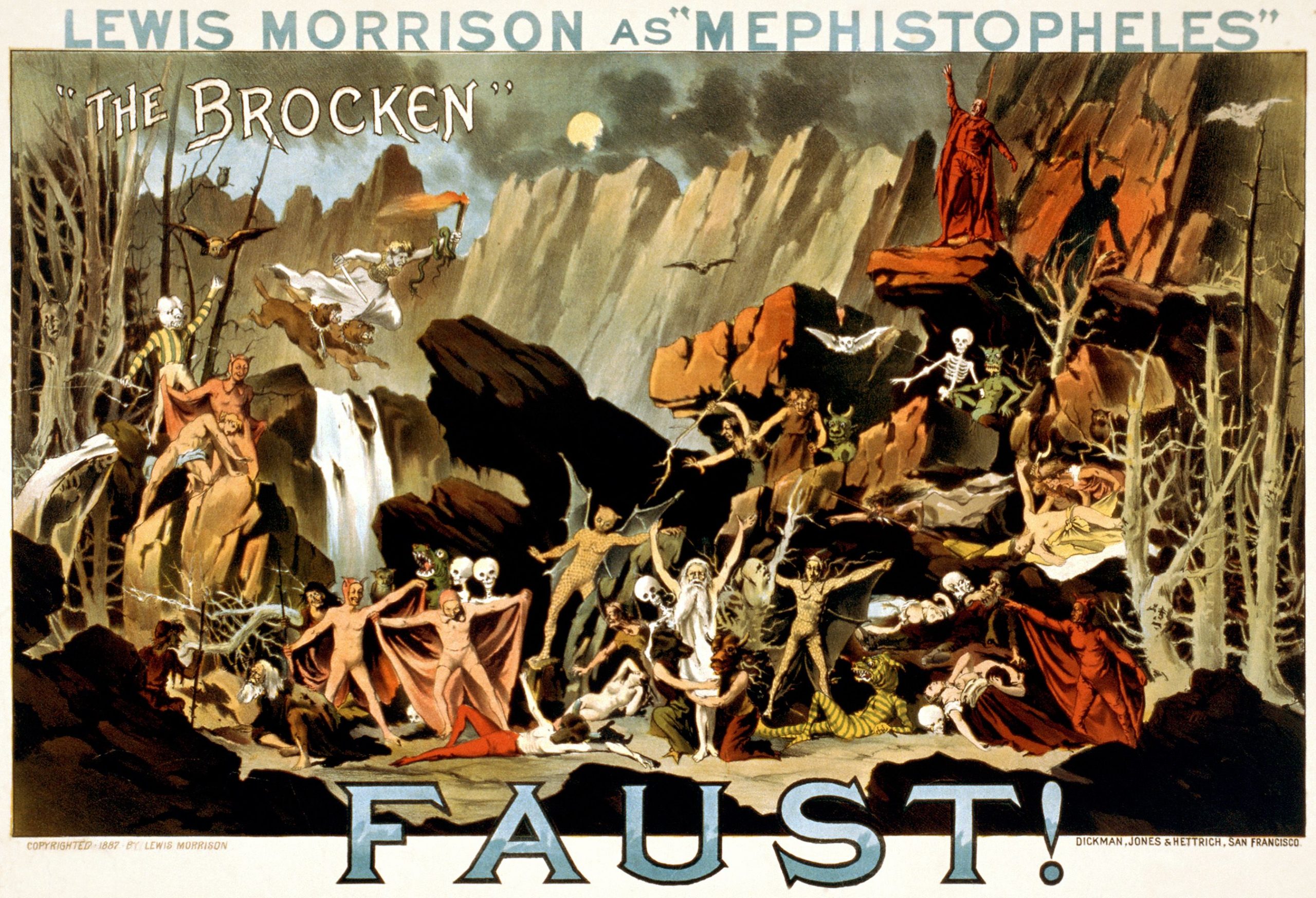
In some sense Ringo represents the lonely and misunderstood part of us, capable but somehow lacking, like a candle with a flickering flame. As in Goethe’s Faust, quoted above, Ringo is visited by an apparition from beyond at the time when he is ready to take his own life: “I’d jump into the River Mersey, but it looks like rain.” In the 2nd century A.D. a young man called Zostrianos, “deeply troubled and despairing”, walked into the desert with the intention of killing himself. But “as he stood alone, steeling himself to do so, he says that suddenly he became aware of a being radiating light” who asked him if he had gone mad, or what. (The document, called the Revelation of Zostrianos, was found in Nag Hammadi in 1945; see Elaine Pagels Revelations, Visions, Prophecy, & Politics in the Book of Revelation).
The crisis in Pepperland is a kind of “war in heaven”, an unknown or at least undeclared conflict that determines what is to come. Because of that, the actors in the Yellow Submarine film, such as Ringo, are not aware of what is at stake, although they certainly suffer the consequences of it; these running much deeper than the risk of losing the pleasantries of fragrant-mowed-greens or rocking-chair country life (with free music and love for all) that are portrayed at the beginning and end of the film. This “war in heaven” I have identified earlier with a conflict taken place in the human soul (there is no other way to call it), and provoking the sudden surge of messianic fervor that grabbed the masses wherever The Beatles went. Looking back, it was not entirely coincidental that the prudery and emotional neglect of a tight-upper-lip society like the British would end up re-enacting the mystical (as opposed to cultist) counterpart of the French Revolution a couple of hundred years later, and for a very short time enthroning La déesse Séntiment instead.

Pepperland itself would deserve more than an offhand consideration. Pepper spice was first introduced to Europe during the Roman Empire. Pepper, along with other valuable spices, was highly sought after for its flavour and medicinal properties. It was imported from regions such as India and Southeast Asia and became a luxury commodity in Europe. Any viewer of the Yellow Submarine film would be perfectly justified to think of “Pepperland” as “Spiceland”, or say, India. The fact that Pepperland (under attack by the Blue Meanies – where do they come from?) displays all the leisure and recreation of the gardens of Victorian higher and upper-middle class, even if it brings the Spice-land a little too close to homeland shores and the White Cliffs of Dover. An astute viewer could be forgiven to think of the visionary prospect of the British Isles as the “Spice Isles” or “Pepperland”, full of colour, populated by every race and and trace of its Commonwealth and beyond, as I believe it is (finally) today, after all.
Like Faust, Ringo and the rest of the band are taken to far-off colourful lands, where monsters roam. Fred is not precisely the Mephistopheles we would expect, but he is certainly a messenger; harmless this time, and unlike the devil an aging one. And yet, the bet is set.
She and the Eternal Feminine?
Look out! ‘Cause here she comes.
Helter Skelter by J. Lennon and P. McCartney
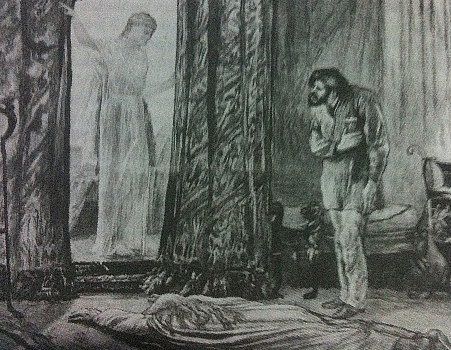
It is not my intention, as I mentioned earlier, to overemphasize the spiritual or mythological gradients of the Yellow Submarine film (which may be possibly completely absent from the mind of its authors, and certainly from the song!), but it is hardly avoidable to connect the film’s imagery with a more general background that transcends the aesthetics and technicalities of the entertainment industry. Like Ringo, or Zostrianos, or Hamlet and Faust for that matter, at the critical moment, and as if on cue, the messenger from heaven (or hell, “submarine” or otherwise) arrives and the tragedy begins. From a certain perspective the Yellow Submarine film alludes to a reality, that of a nation and its people, that shares some traits with tragedy. Or at least with the kind of comedy where a character or group of characters very nearly succumb to a trial, sinister plot, or ordeal, signalling a climatic point before the story straightens up and climbs up to new heights of relief and wish fulfilment.
As it is the case with all great dramas, then, there seems to be almost inevitably a female character that must carry the burden, or perhaps the blame of a child marked by destiny in some manner. The child is usually the resolution of the initial conflict or the unwanted heir of a new world, and it is therefore persecuted from birth. The mother is the proxy culprit, the scapegoat of that conflict, from the wretched Gretchen to the Woman of Revelation 12, but also the final secret aim of the plot, usually transformed into another character or transfigured.
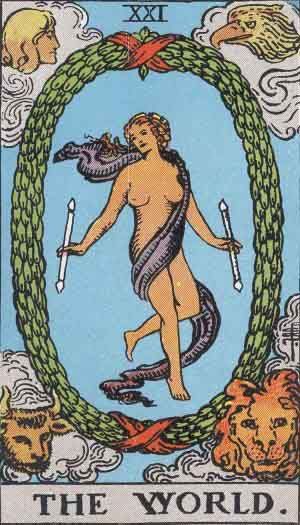
In the Yellow Submarine motion picture the female character, commonly characterized in literature and movies as a cursed pregnant woman, unfaithful wife, witch, harlot, or vampire, belongs to the category of the City of God, Utopia, or New Jerusalem: in other words, the “Promised Land” to be reached at the end of the Yellow Submarine‘s successful quest. At the beginning of the film, we see the unfolding of the ancient myth of the expulsion from paradise theme that spans from Gilgamesh and Utnapishtim all the way to Milton’s Adam and Eve, and leading to the very reversal of this theme in modern dystopian literature: Bradbury’s Fahrenheit 451, Yevgeny Zamyatin’s We, together with Orwell’s 1984, Huxley’s Brave New World, Margaret Atwood’s The Handmaid’s Tale, Burgess’s Clockwork Orange, down to Nolan’s Logan’s Run or the tacky Blake’s 7 (Kazuo Ishiguro’s Never Let Me Go, Station Eleven by Emily St. John Mandel, and Cormac McCarthy’s The Road well deserve to be in the list too, among others). Add to these the treatment of apocalyptic end-of-times mythologem in a whole range of contemporary comics and graphic novels, film and television, and we may begin to glimpse the importance of a “New Hope” or a future promised land.
This problematic, which we may characterize as promised land gone wrong, is already present in the “Blue Meanies“, the original characters first portrayed in the Yellow Submarine film. Blue because they are sad, or maybe because red is good; that I do not know. The plot at this point may seem rather trite or naïve, but we should not forget that it is after all an artistic proposal, the answer to a question posed by the society in which it was conceived and created, and as such a reflection of that society through an imaginative lens. Two world wars and major revolutions, with millions of casualties due to violence, disease, and famine had clearly implanted in everyone’s mind that the world could be a better place without noisy ideologies and utopian rants.

In apocalyptic literature and media output the one character that is most closely related to my work as a composer is the persecuted woman, as it appears first in Revelation 12 (imaginatively anticipated in Revelation 2 and 3 by an admonishing John, righteous and fair in his discontent). She is said to be “clothed with the sun, and the moon under her feet, and upon her head a crown of twelve stars”; in other words, she is the living presence of the enfolding sky and the visible universe. “She” is, simply is, and continuous unabatedly to be whichever way the times run, and Goethe seemed to know this.
At the very end the society of the book or the elected is finally re-established and the paradise regained. Just as in Pepperland.
The Seven Seas
Once the quest has begun, the symbolic character of the yellow submarine is heightened and begins gathering around it other connotations. The more remote UFO associations give way to a more Jonah-like tale in which the four Beatles travel under the sea, confront the monster, meet the helpful friend or “totem” creature, Ringo presses the “panic button”, and finally after slipping in and out of a “Sea of Holes” they proceed beyond onto the “Sea of Green” and Pepperland, now fully colonized, and subject to the authoritarian (and clearly sadistic) iron grip of the Blue Meanies. The seven seas parody list goes as this: Sea of Time, Sea of Science, Sea of Monsters, Sea of Nothing, Foothills and Headlands, Sea of Holes, and the Sea of Green. The eighth stop being of course Pepperland, the promised land.
The yellow submarine thus acts as a kind of ark, surviving a symbolic deluge, reaching the confines all the known world (the seven seas), and at the same time carrying the hope of a new covenant that will integrate or “depotentiate” the evil meanies. We could say that, similarly to the Blue Meanies engulfing and covering Pepperland in blue, the Yellow Submarine encapsulates The Beatles too. I will not press this point much further, but suffice to say that the “femininity” if I may call it so, or pregnant meaning of the yellow submarine is also an almost unavoidable association. Blue or Yellow.
(For an interesting glance at the feminine symbolism of the ark you may visit (among many other links, with diverse orientations) the following link: “The Virgin Mary and The Ark of the New Covenant“[3]pdf, or this[4]pdf.)
About “depotentiation” Jung writes:
It is not a matter of indifference whether one calls something a “mania” or a “god.” To serve a mania is detestable and undignified, but to serve a god is full of meaning and promise because it is an act of submission to a higher, invisible, and spiritual being. The personification [of psychic energy with a god] enables us to see the relative reality of the autonomous system, and not only makes its assimilation possible but also depotentiates the daemonic forces of life. When the god is not acknowledged, egomania develops, and out of this mania comes sickness.” (Commentary on “The Secret of the Golden Flower”)

In the context of the film the depotentiation has therefore a negative character, meaning that the religious symbol, if that is perhaps what the yellow submarine could be hinting at, is devalued and the “egomania” and “daemonic forces of life” take its place. This type of thing also happens in fairy tales and popular stories, which is the genre to which the Yellow Submarine film properly belongs. At the time, the makers of the film were living in a society (we still are) were the “loss of God”, speaking in every-day life practical terms, had made manifest for all to see that sickness brought about by the “egomania” and demonic forces of life.
After the film
They used us as an excuse to go mad. The world did, and then they blamed it on us.
George Harrison, The Beatles Anthology, Disc 3 (21’06”)
And offshoot of the Yellow Submarine movie was a magazine publication called unsurprisingly The Official Beatles Yellow Submarine Magazine (King Features Syndicate and Subafilms, Ltd., 1968), published jointly by Pyramid Publications, Inc. and King Features Syndicate. At some point the Yellow Submarine story begins, at first introduced as in the film with the famous: “Once upon a time, or maybe twice”; but it is what follows that makes it relevant here:
“… eighty thousand leagues beneath some far-off ocean,
stood a huge rainbow gate.”
And then goes on to say that inside the gate was a “magic land called Pepperland, where flowers grew, butterflies flew and the people were all happy.”
The variation is significant in as much as it introduces what could arguably be understood as the gates to the Garden of Eden. Also in 1968 Gold Key Comics, an imprint of Western Publishing, released a comic version of the film in which another twist is added to the Yellow Submarine complex. The Beatles, now characterized as “four Liverpool lads”, are already onboard of the Yellow Submarine in a mission of “mersey”, and with the objective of driving out from Pepperland “bluetocracy and make freedom ring-a-ding ding!” [italics added]. It says that Pepperland was “the happiest of happy places” but that is now under the “gloom of the Blue Power”. The paradise lost is no longer fairy land: it is now democracy or at least the usual conflation of freedom=democracy (or vice-versa) commonly used by most westerners.
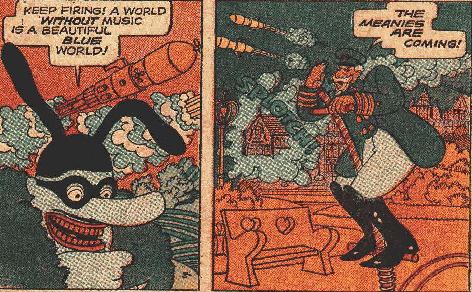
The association of the Blue Meanies with the Soviet Union is clearly intended, and by extension with the threat of authoritarianism, which after the fall of the Soviet Union became painfully visible in the western world too in the form of the so-called “Western imperialism”
1968 was an eventful year, only months away from man’s first landing on the moon, that year saw the assassination of Robert F. Kennedy and Martin Luther King, the Tet Offensive and the My Lai massacre of unarmed civilians in Vietnam, the Prague Spring, student demonstrations in Paris (and the world over), and more; you may check it here[5]or pdf if you wish. [Since editing this article an interesting book called, of all things, 1968: The Year that Rock the World, by Mark Kurlansky, has come to my attention. The author rightly says in the introduction that: “There has never been a year like 1968, and it is unlikely that there will ever be one again[6]I am editing this article in June 2021, and having second thoughts about this assertion.. At a time when nations and cultures were still separate and very different […] there occurred a spontaneous combustion of rebellious spirits around the world.”
The illustrations accompanying the attack of the Blue Meanies in the Yellow Submarine comic show what looks very much like a nuclear missile attack on, we may suppose by the looks of it, London or some other Victorian style good-old town.
The association of the Blue Meanies with the Soviet Union is clearly intended, and by extension with the threat of authoritarianism, which after the fall of the Soviet Union became painfully visible in the western world too in the form of the so-called “Western imperialism” (as far as this article is concerned, and in the context of early 20th century Britain to our day, where those “four lads from Liverpool” lived, you may find an interesting source of information in Fascism in Britain by Richard Thurlow . In the space of a few months, and following the immense popularity of the film, the entertainment industry came up with a magazine+comic follow-up that departs from the original music-and-love surface scope of the film and becomes entangled in the dramatic events taking place in those fateful years of the 20th century. The lost paradise of Pepperland, originally the bucolic and melodramatic “Green and Pleasant Land”, was soon becoming the one that was now being lost; and so the ideas of individual freedom and collective justice that the youth demanded, and which important intellectuals signaled in their work (the 60’s were the golden decade of the French deconstructionist philosophy), began to be re-contextualized in an environment in which vague universal political ideals and supposed threats from the communist monster began to stifle any possibility of a society of coexistence and understanding. John Lennon, of whom I will speak shortly, would eventually codify these vain hopes in the lyrics of his song Imagine; that, very shortly before his assassination, which could be taken symbolically as the swansong of the movement that The Beatles themselves personified; two decades of love. The Yellow Submarine phenomenon, like a cultural product of that time and place, begins to trace the change from Fred’s lawn-mower society to the “global village” (or more likely ‘global farm’) of today.

“And they’re wheeling all the paraplegics in so that they could touch them, it was like Jesus almost”
(George Martin).
The remarks that John Lennon made about Jesus and religion in 1966 stand as a formidable bias against the inclusion of this subject (religion and religious feelings) in a strictly neutral and cool-minded discussion regarding the impact of the band (and the movement they represented) in our modern society; this is truly unfortunate, not the least because the social and spiritual background in which that assertion was made granted the possibility that those observations had a social origin, and not, or at least not only a personal one. In this context, it is my believe that not enough relevance has been given to the fact that, at some point in their career as professional rock musicians The Beatles were approached by people who would bring sick relatives or children in order to be healed. In disc 4 of The Beatles Anthology video set, dealing with the two years previous to John Lennon’s statement, George Martin, The Beatles producer, comments on this in no uncertain terms:
“Everywhere, there were hordes of people trying to get hold of them, trying to get their autographs, trying to touch them. Everywhere they went they were brought cripples, by the way […] And they’re wheeling all the paraplegics in so that they could touch them, it was like Jesus almost.”
Derek Taylor, The Beatles’ Press Officer, next calls the whole situation nightmarish and appears to agree with George Martin: “There was without doubt a lot of opportunism. There were people pushing wheelchairs who were bonkers. The people in the wheelchairs were victims of whatever had got them there and also the prisoners of these people.” Later on Ringo speaks of children victims of thalidomide, and in chapter 3 of the same series he talks about an startling case in which a man in crutches, in a crowd which had gathered to greet The Beatles, “was shouting getting all excited. I saw him throw his crutches away, like he was healed, and he fell right on his face: he just fell over. [Italics added]”.
There are different kinds of religious experience, and an even richer and variegated number of ways of evaluating them. In the context of this article the relevant factor must be the social projection of that experience and the shared belief it engenders. John Lennon was by no means a messiah (nor The Beatles for that matter), but the society in which he lived, and which he, together with his fellow band members, inadvertently helped to set alight certainly was ready for one. The wave of enthusiasm, near-fanaticism, ecstatic fervour, and group consciousness that swayed the the youth of that period stirring the deepest spiritual profundity of the sixties and seventies has only religious precedents in history: it was, truly, a revolution of the heart and soul of men that one may trace back all the way to the crusades, but certainly more to the unfinished business of the French and American revolutions. Had John Lennon uttered an slightly different statement, such as “”we are more important to the queen and the establishment than Jesus or religion”” the American youth that trampled and smashed The Beatles’ records and memorabilia in organized happenings may have sooner been tempted to storm Buckingham Palace instead, should the opportunity had arisen. John Lennon’s argument was thoroughly misplaced, and the context muddy and confused; he was plainly wrong saying what he said the way he said it, and so he triggered a negative (and completely understandable) emotional tsunami reaction, channelling the always delicate religious feelings of the people against him instead; and, it should be added, offering a moment of respite to an already worried establishment, which possibly heaved a loud sigh of relief when hearing the news.
References
| ↑1 | pdf for broken links |
|---|---|
| ↑2 | Scanned by Holly Voley (http://home.comcast.net/~vilex/) for the public domain, and retrieved from http://www.sacred-texts.com/tarot (see note on that page regarding source of images), PD-US, https://en.wikipedia.org/w/index.php?curid=17299785 |
| ↑3 | |
| ↑4 | |
| ↑5 | or pdf |
| ↑6 | I am editing this article in June 2021, and having second thoughts about this assertion. |


